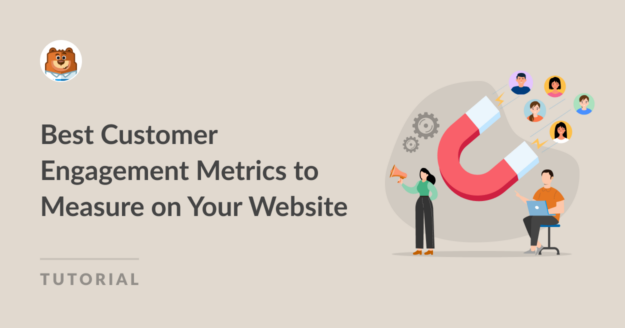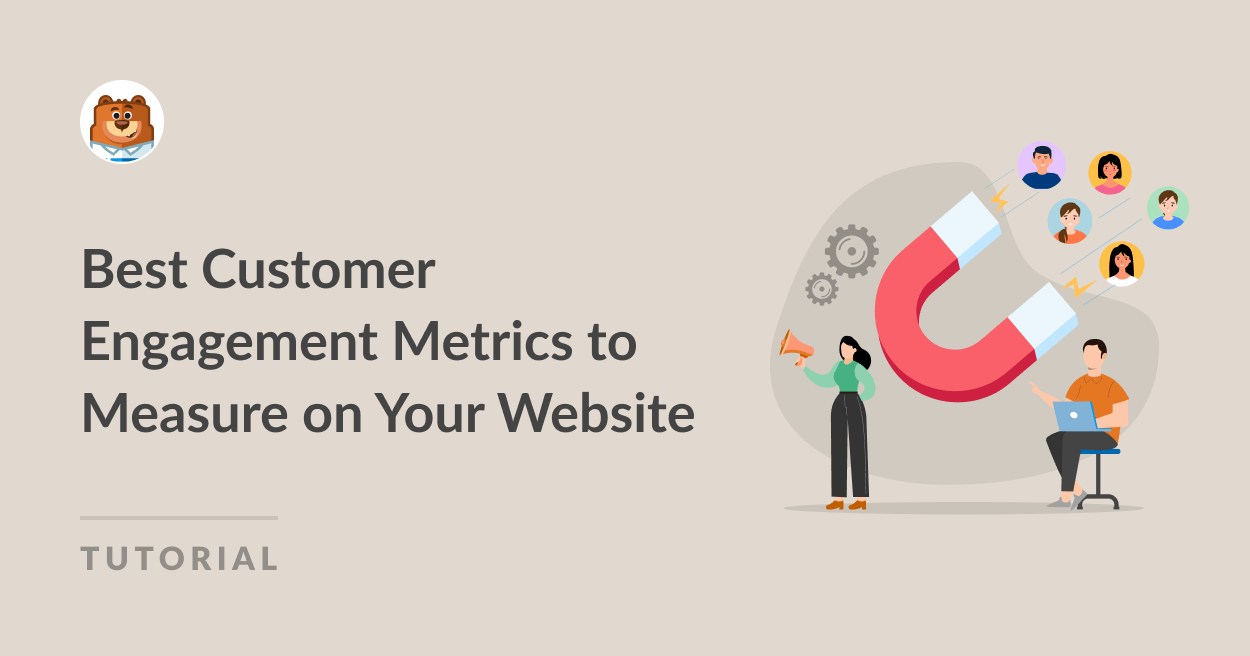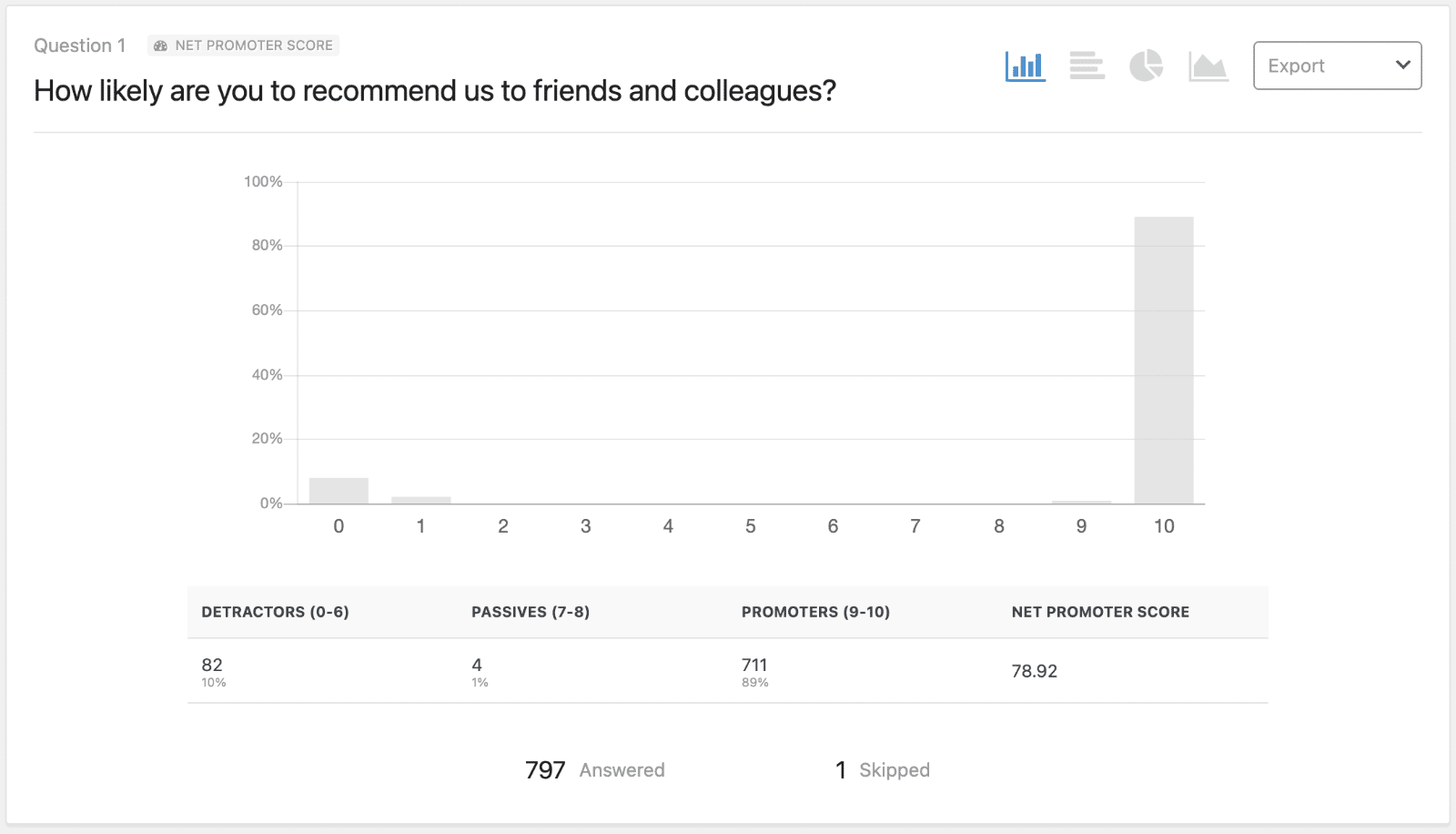Are you looking for the best customer engagement metrics to measure how well your website connects with your visitors?
Understanding customer engagement helps you make better decisions that keep your audience interested and interacting with your content, which leads to more sales and better customer satisfaction.
In this article, we’ll explore the top 11 customer engagement metrics essential for any website owner.
In This Article
- 1. Net Promoter Score (NPS)
- 2. Customer Satisfaction Score (CSAT)
- 3. Form Conversions
- 4. Conversion Rate
- 5. Average Session Duration Time
- 6. Customer Retention Rate (CRR)
- 7. Returning Customers
- 8. Social Media Engagement
- 9. Email Engagement
- 10. Churn Rate
- 11. Customer Lifetime Value (CLV)
- Best Customer Engagement Metrics to Measure FAQs
Why Measure Customer Engagement Metrics?
Understanding customer engagement metrics is key to improving your website and business. These metrics show how people interact with your site, helping you make smart changes that enhance their experience. Here’s why they’re so important:
- Boost customer satisfaction: See what your customers like and give them more of it, making them happier and more satisfied.
- Drive business growth and retention: Happy customers stay loyal and keep coming back, which helps your business grow steadily.
- Refine your strategy: Learn what works and what doesn’t, and use this knowledge to make better business decisions.
- Predict future trends: Watch how customer interactions change over time to spot upcoming trends and stay ahead of the competition.
- Personalize your customer experience: Make each customer feel special by using what you learn to provide personalized experiences.
Measuring customer engagement is about truly understanding your visitors and using that knowledge to improve their experience. I’ll explain more about how you can continuously make improvements based on what you discover.
11 Best Customer Engagement Metrics to Measure on Your Website
Ready to dive into the best customer engagement metrics for your website? Let’s get started!
1. Net Promoter Score (NPS)
Net Promoter Score (NPS) surveys provide fantastic metrics for measuring customer engagement on your website.
These surveys ask customers to rate their experience with your product or service, typically on a scale from 0 to 10, and inquire how likely they are to recommend your business to others.
The feedback gathered through NPS surveys provides a clear picture of your customer satisfaction levels and highlights areas for improvement.
Pretty neat, right?
WPForms is the most user-friendly plugin for building survey forms, making creating and managing NPS surveys easy for WordPress users.
With the Surveys and Polls addon, you can easily set up, customize, and analyze your surveys directly from your WordPress dashboard.
You can customize questions to fit your needs, see real-time stats, and make data-driven decisions to enhance your services or products.
Create Your NPS Survey Form Now
Using WPForms for your NPS surveys means you don’t need to worry about the technicalities of form creation or data analysis. It simplifies the process, allowing you to focus more on interpreting the feedback and growing your business.
Read our complete guide on how to create an NPS survey in WordPress.
2. Customer Satisfaction Score (CSAT)
While the Net Promoter Score (NPS) assesses the likelihood of customers recommending your service or product, the Customer Satisfaction Score (CSAT) measures how happy they are with a specific interaction or purchase.
CSAT focuses directly on customer happiness with a recent experience rather than their overall loyalty to the brand. This means that CSAT provides feedback specifically about a recent service or purchase, giving you immediate insights into how customers felt about that interaction.
For instance, ask your customers to rate their experience after completing a purchase.
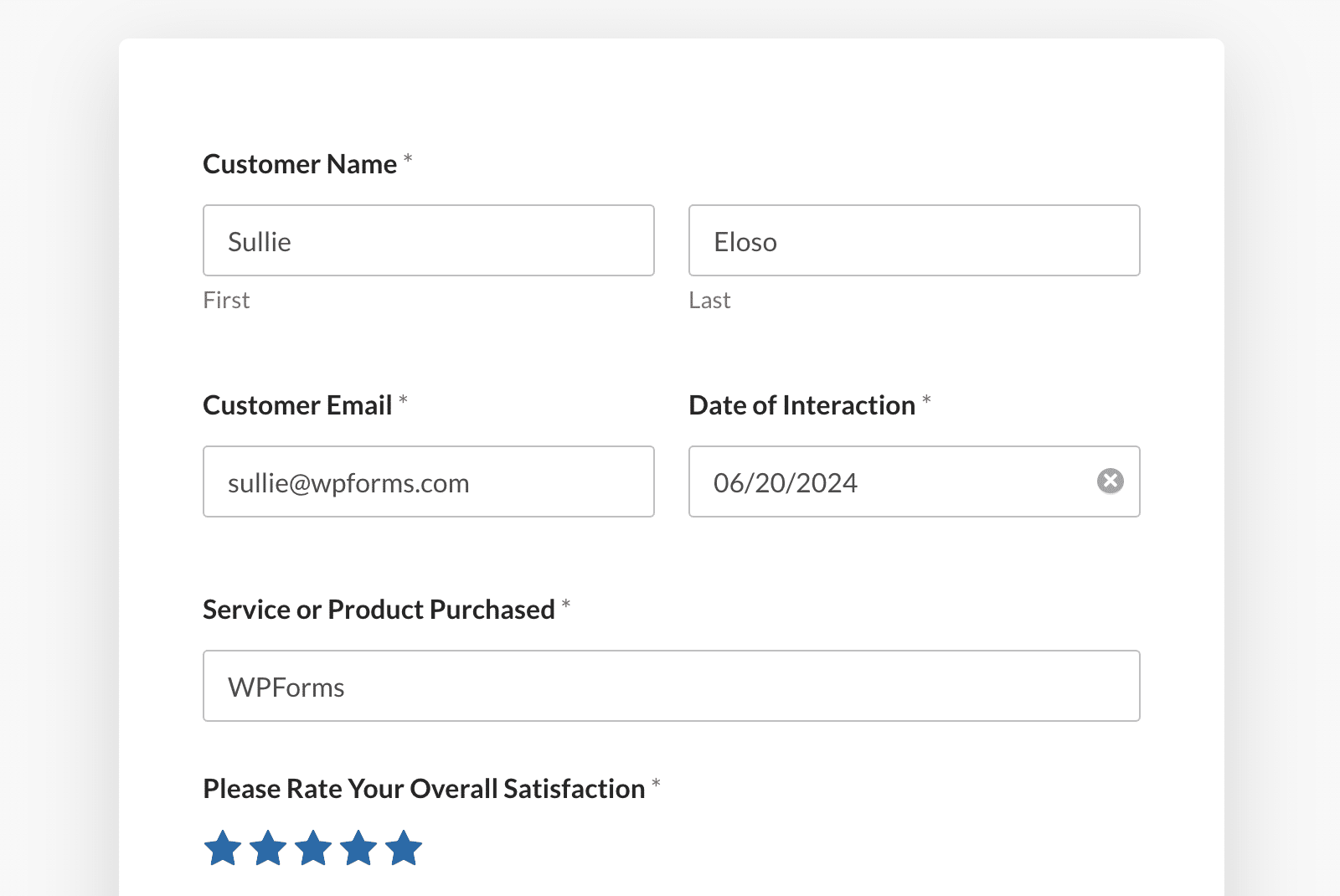
Calculating CSAT is straightforward: customers rate their satisfaction on a scale of 1 to 5 or 1 to 10 after interacting with your service.
To find your CSAT score, divide the number of satisfied customers (those selecting the top end of the scale) by the total number of responses, then multiply by 100 to get a percentage.
Once again, the WPForms Surveys and Polls addon is an excellent choice for efficiently collecting CSAT data for WordPress users. You can also use our CSAT Survey Form template to quickly get your CSAT form up and running.
It allows you to effortlessly customize your surveys to gather the exact feedback you want, ensuring you can measure customer satisfaction accurately and effectively.
3. Form Conversions
Form conversion rates are excellent metrics for tracking customer engagement. They show which forms capture your audience’s interest and which are effective at converting visitors into leads or customers.
Having forms on your website helps you stay in touch with visitors and see how they interact with your content, like when they sign up for emails or place orders.
It’s important to know which forms grab your audience’s attention and get them to take action. Once you know which forms work best, you can use similar ones on different parts of your site to improve how often visitors engage with them.
For WordPress users, the simplest way to track this is to use the MonsterInsights plugin. It automatically tracks all form conversions and provides the information in detailed, easy-to-read reports, right inside your WordPress dashboard.
This way, you quickly see which forms are performing well and which ones might need some tweaks.
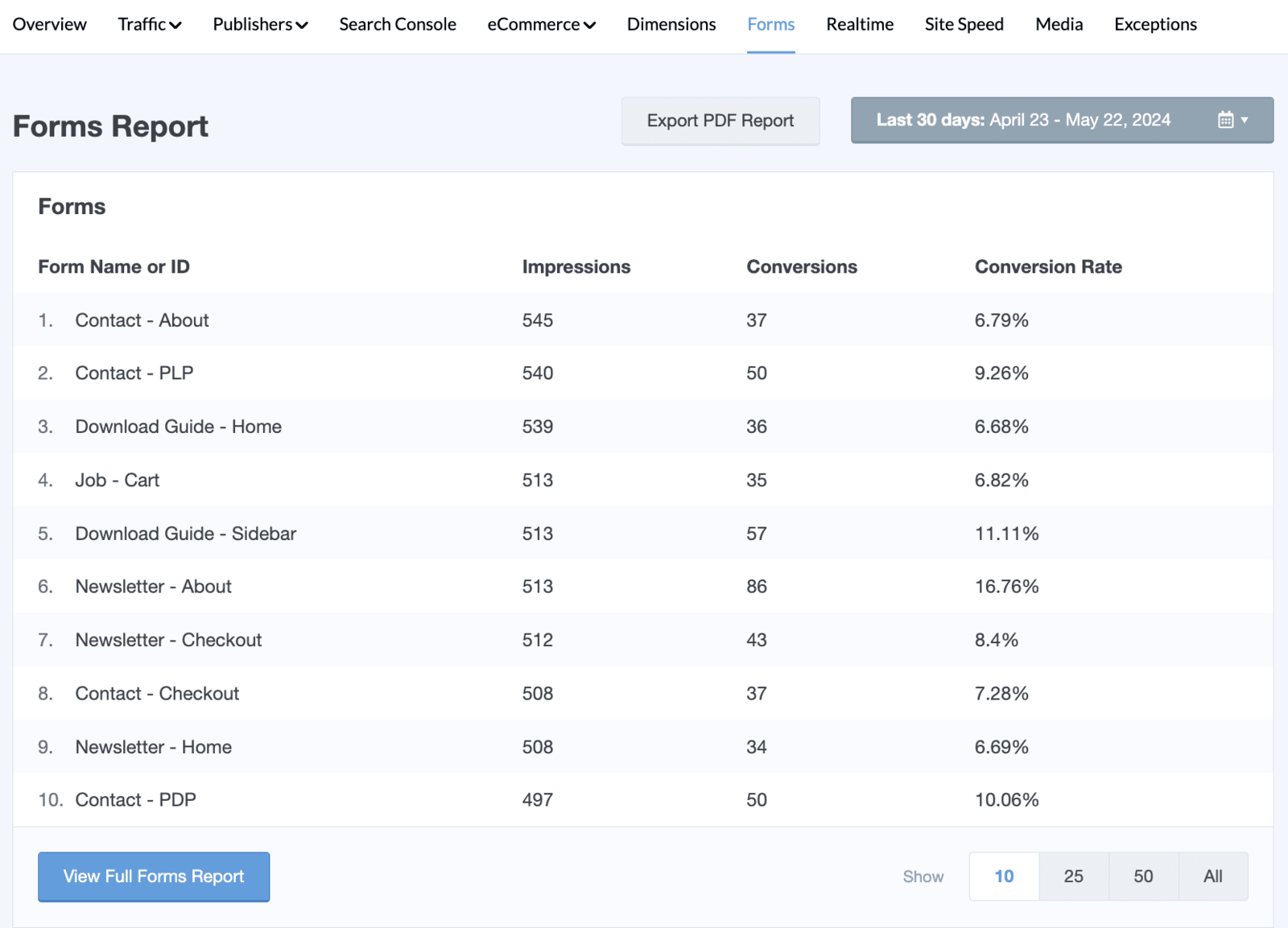
Using these insights, you can make informed choices to improve your forms and boost visitors’ interactions with your site, all without needing complicated setups or manually tracking things.
For those not on WordPress, you’ll need to set up form tracking manually using Google Analytics and Google Tag Manager. This involves setting up event tracking and triggers to capture form interactions.
Check out our guide on how to track form conversions to learn more.
4. Conversion Rate
Next, let’s talk about your conversion rate.
Whether you’re encouraging customers to download an eBook, subscribe to a newsletter, or make a purchase, the conversion rate will tell you how effectively your campaign turns visitors into active participants or buyers.
This customer engagement metric shows you how successful your marketing campaigns are and provides insights into your return on investment (ROI).
Calculating your conversion rate is pretty straightforward. You divide the number of successful conversions by the total number of visitors, and then multiply the result by 100 to get a percentage.
For example, if your campaign’s goal is to have visitors sign up for your newsletter and 33 out of 100 visitors did, your conversion rate would be:
Conversion rate = (33/100) × 100 = 33%
This simple math is a powerful tool for assessing how well your site engages and converts visitors.
For a really easy way to set up conversion tracking and see different conversion rates inside your WordPress dashboard, install MonsterInsights. Use the plugin to track:
- eCommerce conversions: See how many visitors complete purchases and much more.
- Ads conversion tracking: Measure the effectiveness of your Google, Microsoft, and Meta ads.
- Landing page performance: Identify which landing pages are most effective at converting visitors.
- Affiliate link tracking: Understand which affiliate links bring the most conversions.
- Marketing campaign tracking: Use custom URLs to track specific campaign conversions.

Using MonsterInsights, you can track virtually any campaign on your WordPress site with just a few clicks.
This helps you see precisely what’s working and what isn’t, helping you optimize your campaigns for better engagement and higher conversion rates.
5. Average Session Duration Time
The ‘Average Session Duration’ metric tracks a visitor’s average time on your website during a single session.
This metric is great for marketers to use to identify which products or content capture customers’ interest, particularly on specific pages like landing pages.
For instance, if blog posts have a high average session duration, they really interest your audience. This guides you in creating more content on similar topics.
While Google Analytics offers tracking of session duration and additional insights such as audience demographics and location, you can also get them right inside your WordPress dashboard with MonsterInsights.
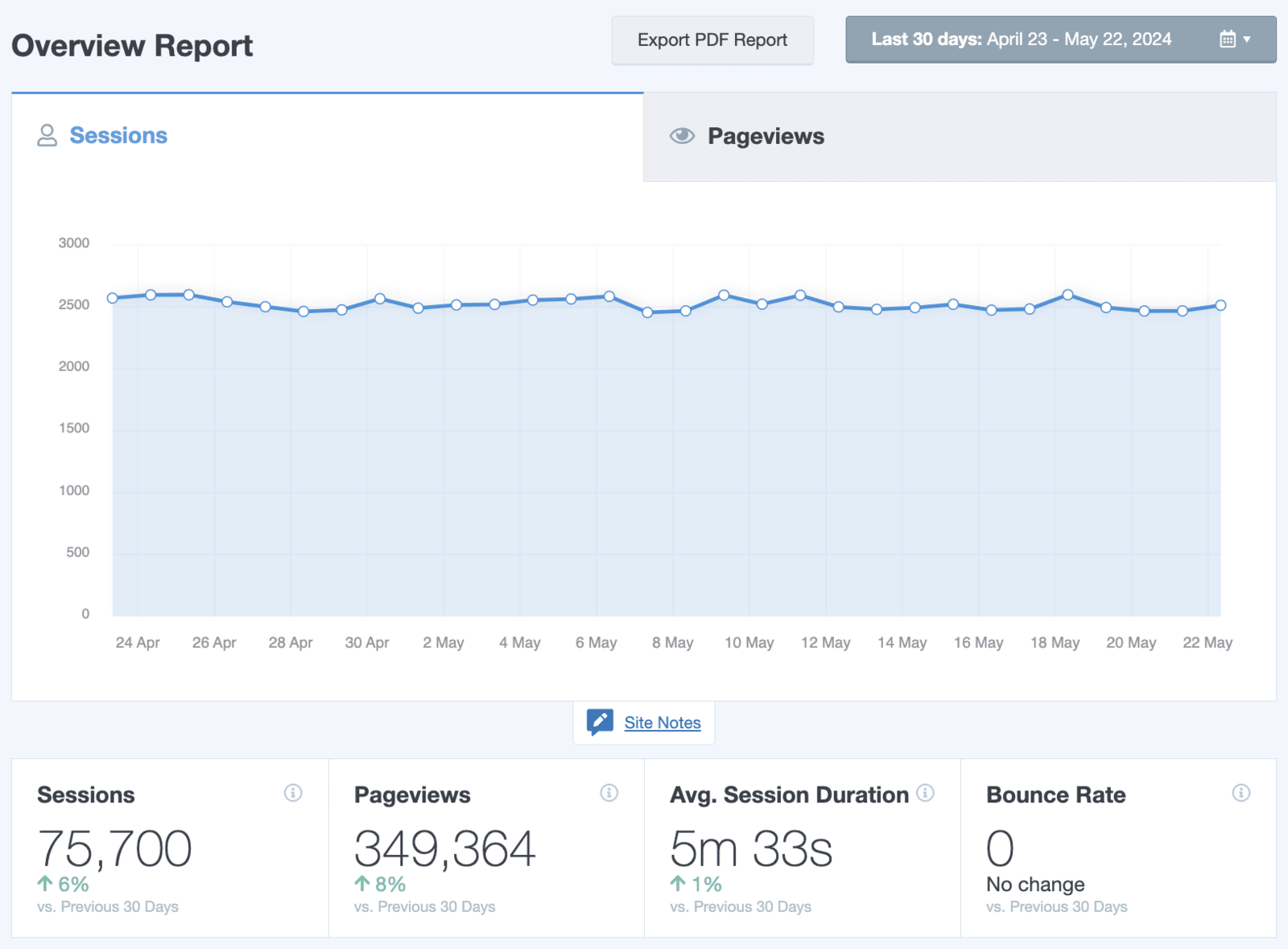
6. Customer Retention Rate (CRR)
The Customer Retention Rate (CRR) is another great customer engagement metric worth considering. It measures a business’s ability to keep its customers for a period of time rather than just making a single sale.
It reflects how well a company maintains ongoing customer relationships, ensuring they don’t turn to competitors. Retaining customers is a more sustainable and easier way to grow your business than repeatedly finding new ones.
To calculate the Customer Retention Rate, use this formula:
CRR= (E – N/S) x 100
Where:
E is the total number of customers at the end of the period,
N is the number of new customers acquired during the period,
S is the number of customers at the start of the period.
For example, imagine your business started the year with 100 customers (S), gained 30 new customers over the year (N), and had a total of 110 customers by the end of the year (E). Calculate the CRR like this:
CRR = (110 – 30/100) x 100 = 80%
This means that your business retained 80% of its customer base through the period. I’d say that’s an excellent indicator of customer loyalty and satisfaction!
Keeping an eye on your CRR helps you see how well you connect with your customers and shows if your methods to keep them are working.
7. Returning Customers
In line with what we discussed above, tracking the number of returning customers is another effective way to evaluate your website’s engagement levels.
Returning visitors strongly indicate that people are interested in your content, products, or services. A high rate of returning visitors typically means that your business or campaigns are resonating well with your audience, encouraging them to come back for more of what they love.
While you can find information about new and returning visitors inside Google Analytics, we recommend MonsterInsights for an even simpler way to access it within WordPress.
Below the Overview Report, there’s a straightforward graph comparing New vs. Returning Visitors, along with a Device Breakdown.

These graphs make it easy to see what percentage of your audience is revisiting your site and the devices they use to access it.
You can also view the percentage of new customers in the eCommerce report.

8. Social Media Engagement
It’s important to monitor how your campaigns perform on platforms like Facebook, Instagram, LinkedIn, and Twitter, where users can interact directly with your brand’s pages.
However, when looking at engagement metrics in digital marketing, don’t just focus on the number of followers or clicks, as these can be vanity metrics that don’t give you valuable insights.
Instead, pay attention to how engagement such as likes, comments, and shares correlate with visits to your website.
A smaller, highly engaged social media audience is more valuable than a large, passive one.
You can easily calculate your engagement rate on social media like this:
Engagement rate = (Total engagements/Total followers or impressions) x 100
With MonsterInsights, you can track clicks from your social media platforms to see how many people visit and engage with your website.
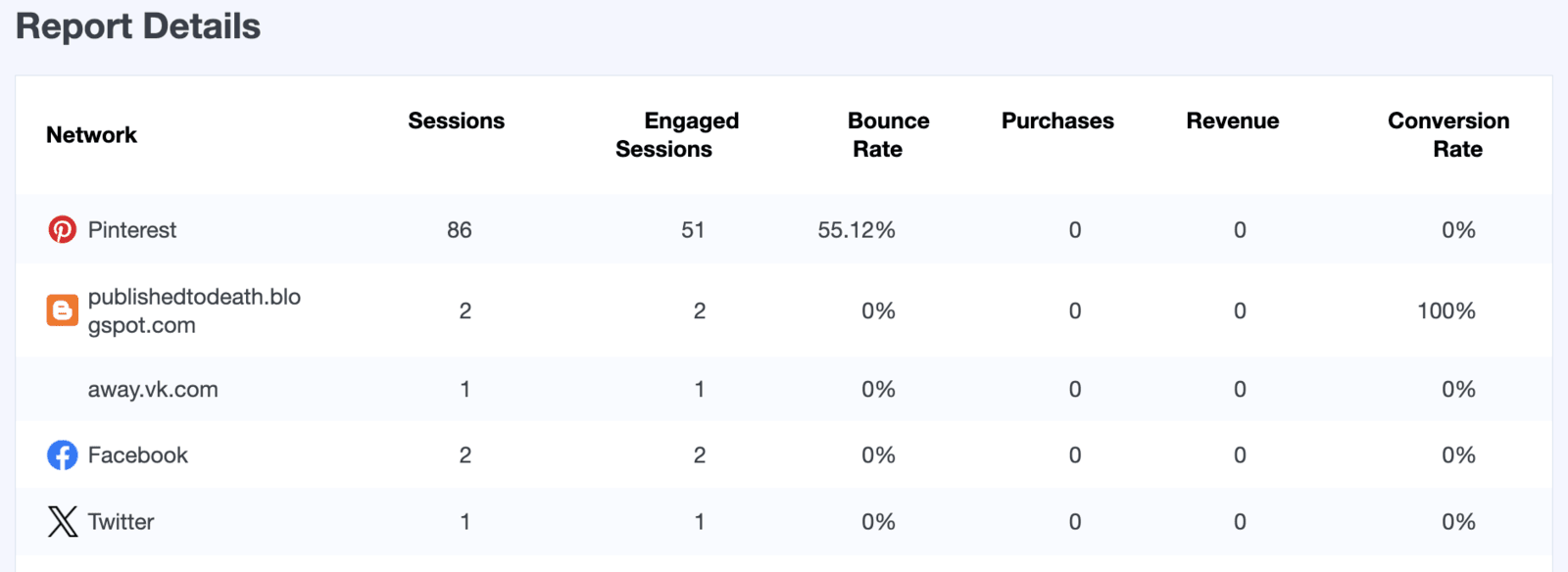
This helps you measure the impact of social media activities on key website metrics, such as sign-ups, downloads, or sales, providing a clearer picture of your followers’ actual value.
Measuring the engagement rates on social media posts that link to your website helps you improve your content strategy to match what your audience likes.
9. Email Engagement
Email engagement metrics give you a valuable snapshot of how your audience interacts with your email campaigns and what you offer.
To get a clear picture, you’ll want to monitor open rates, click-through rates (CTR), and conversion rates, which you can check using your email marketing software.
While having a large list of email subscribers may seem like a win, the accurate measure of success is the number of subscribers who actively engage with your emails — like opening emails, clicking links, and responding to calls to action (CTA).
Creating content that specifically appeals to different groups on your list is a way to increase both open and click-through rates.
10. Churn Rate
The churn rate tracks how many customers stop using your product or service over time, usually measured each year or quarter. This metric is key for seeing how well you keep customers and figuring out why they might leave, helping you shape your customer engagement strategy.
While it’s normal for businesses to have some one-off customers, maintaining a low churn rate is important for long-term success.
A high churn rate might signal problems with your products or customer satisfaction. By examining this rate, you can identify what needs improvement and create strategies to increase customer loyalty.
To calculate the churn rate, use this formula:
Churn Rate = (Number of customers lost during the period/Number of customers at the start of the period) × 100
This formula gives you the percentage of customers who stopped using your service or product over a specific period.
The most effective method for reducing churn rate is using customer feedback surveys to gather insights from your visitors. These surveys gather consumer reactions and opinions about your brand, platform, and products.
This feedback is crucial because it helps you understand your customers’ needs and preferences. With this information, you can adjust your marketing strategies to meet their needs better and boost customer loyalty.
11. Customer Lifetime Value (CLV)
Last on the list for metrics to measure customer engagement is Customer Lifetime Value (CLV). This metric measures how much value your business gets from a customer over the entire time they are with your company.
CLV is particularly useful for understanding the long-term value of having repeat and loyal customers.
Calculating CLV involves understanding how much your repeat customer spends on average, monthly, or quarterly and using this information to estimate how much they might spend over time.
To calculate Customer Lifetime Value (CLV), you can use a basic formula:
CLV = Average purchase value × Average number of purchases × Average customer lifespan
I’ll explain how you find each of those values:
- Average purchase value: Calculate this by dividing your company’s total revenue by the number of purchases during the same period.
- Average number of purchases: This is the average number of times a customer buys from you during a period. To get this number, divide the total number of purchases with the total number of unique customers.
- Average customer lifespan: This is the average number of years a customer continues purchasing from your business.
Multiply these three figures together to estimate the Customer Lifetime Value.
Here’s an example to make it super clear:
A company has an annual revenue of $10,000. During that same year, it had 100 purchases from 80 unique customers. On average, a customer returns to buy more from the business for a total of 2.5 years.
The customer lifetime value would be:
CLV = (10.000/100) x (100/80) x 2.5 = 100 x 1.25 x 2.5 = $312.50
This information helps you predict future earnings and is crucial for planning how much to spend on getting new customers. It also guides you on strategies to keep users active and loyal.
Best Customer Engagement Metrics to Measure FAQs
These are some questions that users frequently ask about customer engagement metrics:
What are customer engagement metrics?
Customer engagement metrics show how people interact with your brand. These include measures like how much time people spend on your website, how often they buy something, and how active they are on your social media. They help you understand what keeps customers interested in your brand.
How do you evaluate customer engagement?
You can evaluate customer engagement by looking at how often people buy from you, how much time they spend on your site, and how they react to your emails and social media posts. Tracking these things helps you see how well your business connects with customers.
What are some customer engagement strategies?
Some good strategies to keep customers engaged include personalizing their experience, rewarding them for staying with you, and regularly asking for their opinions to improve your services. Keeping your social media lively and responsive is also important because it helps build a strong community around your brand.
Next, Build Your Digital Marketing Strategy
And that’s it! We hope you liked this article and learned a lot about the customer engagement metrics you should monitor on your website.
Check out these other articles for more tips on how to attract and retain customers:
- Website Marketing for Small Businesses
- Coupon Marketing Strategy Tips (to Skyrocket Sales)
- Best WordPress Marketing Automation Plugins
- Social Proof Examples to Try in Your Digital Marketing
- Insanely Effective Small Business Marketing Ideas
Ready to build your form? Get started today with the easiest WordPress form builder plugin. WPForms Pro includes 1,800+ form templates and offers a 14-day money-back guarantee.
If this article helped you, please follow us on Facebook and Twitter for more free WordPress tutorials and guides.

